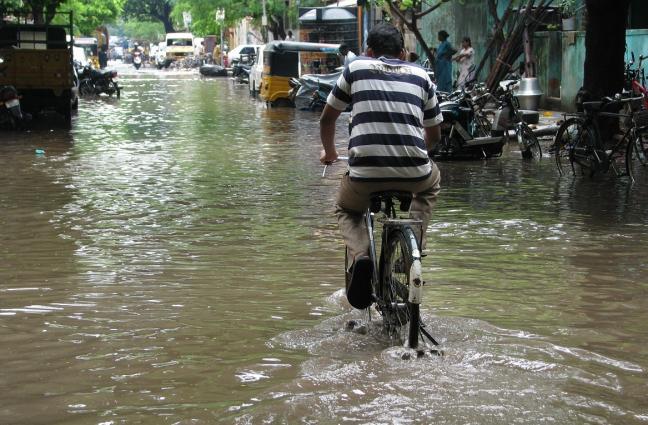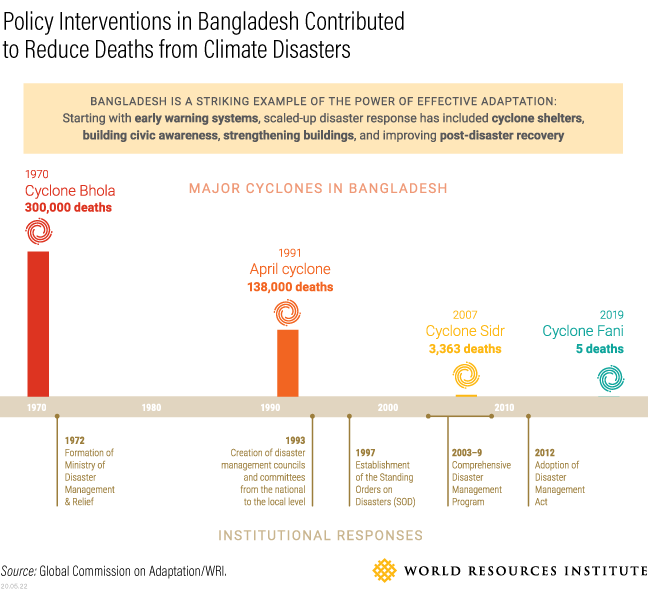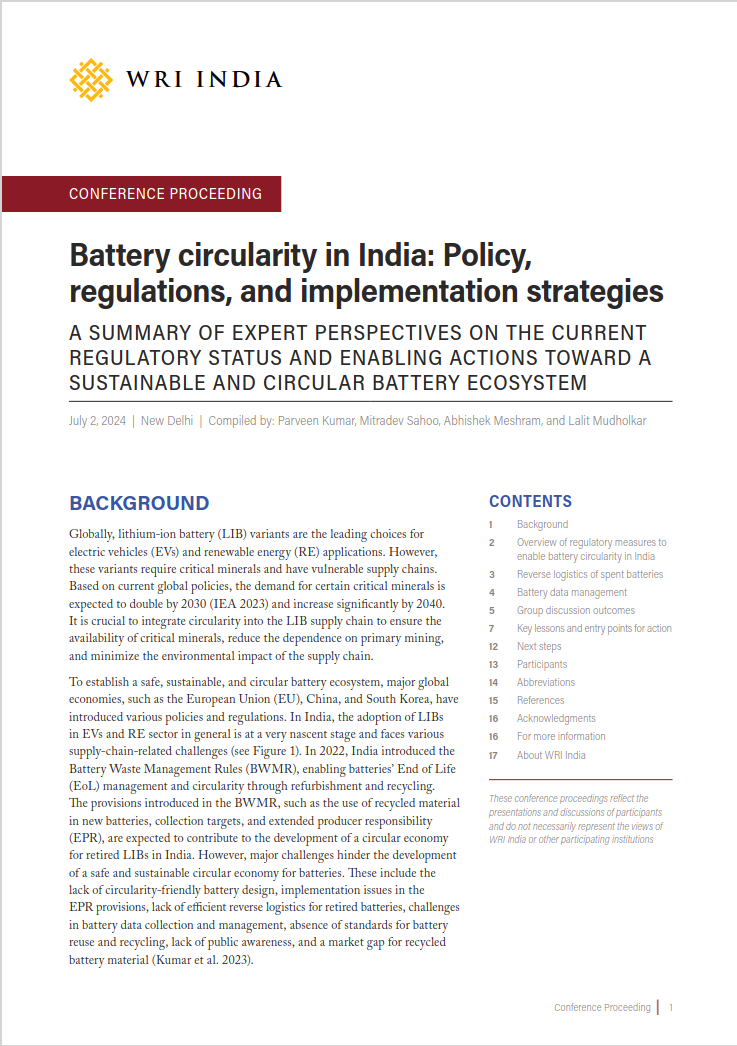South Asia Confronts a Double Disaster: Cyclone and COVID-19
by -
This blog was originally published on WRI.
The axiom for this anxious moment is: coronavirus makes everything more complicated. That has been the case in Bangladesh and eastern India in the season’s first tropical cyclone, Amphan, where high winds and lashing rain threatened the region’s most vulnerable populations. Decades of preparation, plus a weakening of the storm as it made landfall, appear to have mitigated Amphan’s initial impact: the death toll was in the dozens, not the hundreds or thousands. But this natural disaster still wreaked havoc on the region, especially as COVID-19 lockdowns complicated typical disaster response measures.
Coastal communities faced a daunting choice of braving the cyclone by staying put or risking COVID-19 infection in a shelter. About 2.2 million people in Bangladesh and about 4.3 million people from the coastal districts of West Bengal and Odisha states in India were evacuated to shelters.
Bangladesh and India are no strangers to extreme cyclones and have been preparing for moments like this for decades. Bangladesh, for instance, began expanding its disaster response capacity after Cyclone Bhola killed 300,000 people in 1970. The country scaled up early warning systems, built civic awareness, constructed cyclone shelters, strengthened buildings, among other measures, as shown in the Global Commission on Adaptation’s Adapt Now report. While it is too early to tell the full impact of Cyclone Amphan, these decades of investing in preparedness likely mitigated the human and physical toll.

But even the most extensive preparation could not have prepared the disaster management authority for one of its biggest challenges: maintaining social distancing in the cyclone shelter facilities. Sustainable Environment and Ecological Development Society (SEEDS) observes that the usual space requirement for housing disaster-impacted families is 3.5 square metres per person – but with COVID-19, it has risen to 5 square metres to ensure the required social distancing. When accounting for more than 6 million evacuees, this space requirement becomes vast, and precautionary evacuations become meaningless if people contract COVID-19 in the cyclone shelters. As other countries prepare for upcoming hurricane seasons, one lesson may be to create even more shelters to allow people to further spread out. Limited access to safe water, sanitation and health facilities in the relief camps will add to the toll for those already devastated by the pandemic.
Limited Options for Relief and Recovery
In normal circumstances, a monster storm like Amphan would attract external aid for relief and recovery. But now, every country that would have been expected to offer aid is contending with its own pandemic-related problems. Limited logistical support and travel restrictions further reduce response options.
Even internal mobilization of resources will be challenging. Though India has resources to manage the emerging crisis, both India and Bangladesh could face difficulties if damage is heavy. Health services in both countries are struggling to manage the COVID-19 outbreak, making it more difficult to respond to the additional needs the cyclone will bring.
Despite these challenges, humanitarian agencies such as the International Red Cross and Red Crescent Societies are stepping into help. IFRC used a new emergency early action fund to rapidly get funds to affected communities, including evacuations, dried food and drinking water, first aid, and other supplies.
Building Back Better
Preparedness and recovery measures for climate-related hazards will need to change to deal with the added challenges of the coronavirus pandemic—and future health. We should take lessons from Amphan on what was done well and how we can improve disaster response going forward.
The UN Office for Disaster Risk Reduction’s Build Back Better approach offers one possible pathway. Though aimed primarily at natural disasters, some of the suggested measures could be used to respond to pandemics like COVID-19. Approaches like this one can contribute to developing preparedness strategies that incorporate both climate change adaptation and reducing global health threats, especially as projections indicate climate-related disasters are likely to become more frequent and intense.
What It Takes to Deal with the Double Disaster
1. Invest in Health Care Systems
The public health infrastructure in South Asia and other developing regions is generally weak and operates with limited capacity, leaving it unprepared to manage compound health threats while remaining resilient to multiple challenges. India’s proposal to build a global Coalition for Disaster Resilient Infrastructure (CDRI) is a step in the right direction to reduce risks to vulnerable public infrastructure, including health care, transport, clean drinking water, sanitation, telecommunications and electricity, roads and ports.
But what is needed now is a comprehensive approach to deal with multiple hazards. This could mean expanding the scope of the CDRI to include strengthening public health infrastructure.
2. Share Information
Managing these kinds of compound risks requires the effective sharing of information, along with robust data, scientific information and appropriate skills sets and capacities to understand risks and act upon them on a timely basis. Information must not only be shared between government agencies, but it also must reach communities — early warnings of impending threats are only effective if people hear and act on them.
Building healthcare capacities to take on both pandemics and disasters also demands more nuanced understanding, expertise and skills guided by science, while also building capacity in communities to better understand the hazards of a double disaster and plan collective action.
3. Leverage Early Warning Technology
South Asia in general, and India in particular, can draw on a strong information technology sector. Increased availability of satellite data and access to the digital world have enormous scope to provide real-time information to save lives and jobs in the event of disaster. Technology-enabled early warning systems have evolved to help manage disaster risks effectively. Bangladesh, for instance, has dramatically reduced deaths from cyclones over the past five decades by scaling up early warning systems and other adaptation measures.
Investing in early warning systems has huge benefits: they save lives and assets worth at least 10 times their cost, according to the Global Commission on Adaptation’s report. Spending $800 million on such systems in developing countries would avoid $3-16 billion per year in losses.
The same technologies could be applied to disease and pandemic outbreaks, especially in relief and recovery operations. They must be upgraded and expanded to manage complex situations like the one that South Asia is experiencing now.
The Key Lesson: Preparedness Pays Off
The converging of COVID-19 and Cyclone Amphan have shown us that we can no longer think of pandemic preparedness or disaster preparedness in a silo. We must consider both. And with both, there is a common lesson: Investing in early warning and preparedness pays off. By planning ahead for both climate and health risks, we can save lives and strengthen our economies.


